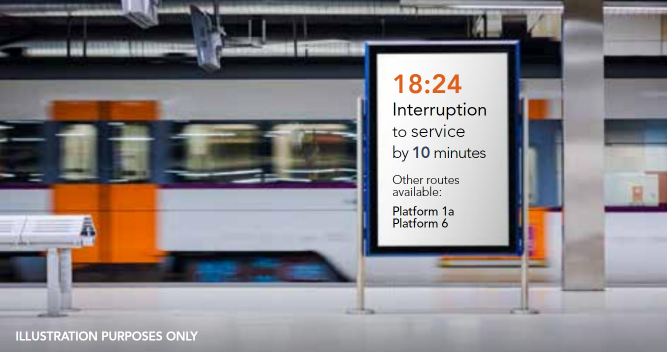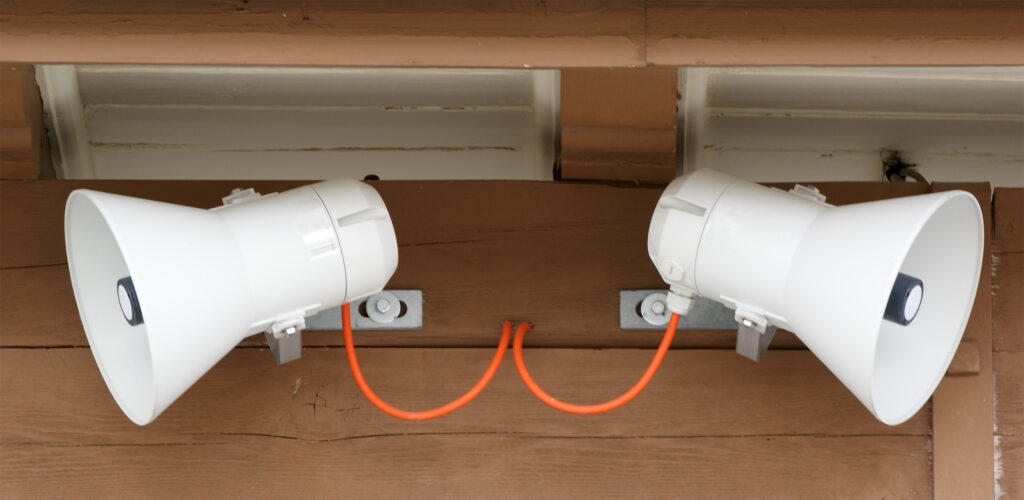In times of rail disruption, having poor information can annoy and frustrate customers. But if people are informed of the extent of their journey disruption and what their options are, this can help to maintain their confidence in rail. Timely accurate customer information is essential so that people can plan ahead. With customer information being so important, Rail Engineer recently met up with Network Rail and the Rail Delivery Group to learn more of the developments in customer information systems.
At the end of 2022, independent watchdog Transport Focus consulted more than 15,000 people to help the railway invest on the improvements that matter most to customers. The top three issues for rail customers were the cost of train tickets and value for money, reliability and punctuality, and sufficiently frequent trains. At number four of the top 10 issues was receiving accurate and timely information about train times. At number seven was being kept informed about train delays and the options customers have in times of disruption.
Four years ago, the Office of Rail and Road (ORR) commissioned research on the provision of information to customers. This showed that whilst there had been some improvements in providing information to customers, it is a challenge, particularly during disruption. The research found there was no clear industry strategy for delivering better customer information, poor understanding of what good information looks like, and a lack of accommodating the needs of all customer groups.

Smarter Information, Smarter Journeys
In response to the ORR’s report, the Smarter Information, Smarter Journeys (SISJ) programme was launched in early 2020. It is a cross-industry programme with a remit to deliver better and simpler customer information. It is a fantastic example of cross-industry collaboration and what can be achieved for the good of the customer and the industry when industry minds from Network Rail, the Rail Delivery Group, and train operating companies come together.
The programme focuses purely on the customer and the desire to enhance customer satisfaction with customer information. It is a very welcome development in improving customer information based on the core principles of customer insight, transparency, and industry collaboration. The goal is to provide customers with all the information they want, when and how they want it. It aims to ensure that customers always have a consistent and simpler customer information experience, irrespective of which train operator they travel with.
Recent results show an impressive increase in customer satisfaction with 67%* of customers being satisfied with information during disruption in May 2023, this is a 10%* increase since SISJ launched.
*Source: InfoTracker Survey Q1 Results (April – June 23)
The SISJ programme has delivered a range of initiatives. Examples include:
- Work undertaken with train operators, retailers, and suppliers to build a tool which notifies customers who have bought a ticket via website/app when their train journey is impacted (known as personalised journey notifications) by timetable changes or other delays. This initiative has been implemented by almost all rail retailers/train operators and to date there have been over 1.9 million passenger notifications.
- Developing a blueprint for train operators to adopt and follow which clearly sets out the type, quantity, and occurrence of on-board announcements, to make sure there is consistency across the network. This was in response to the need to improve on-board announcements and reduce their frequency and repetitiveness as outlined in the Williams plan for rail as shown here.
- Implemented a ‘Data Visualisation’ tool for Operational Information Screens (OIS). This tool looks at how to improve the awareness of asset locations and their condition across the network. The aim is to better prioritise resources and target more accurately faulty devices. For engineers across the network who repair OIS assets, having an update-to-date ‘Data Visualisation’ tool is a more efficient and effective way of working. Engineers can now quickly locate the assets, understand their condition, and rectify any problems in a timely manner.
- Created a Best Practice Guide that is used during severe disruption. During the worst disruption, this guide helps improve the speed and consistency of publicised information and provides train operators with guidance on message creation and customer friendly language. The guide was developed between Network Rail, Rail Delivery Group, the Office of Rail and Road, and Transport Focus.
- Reviewed the functionality of the customer information screens via a specifically set up industry group to agree on a baseline set of functionalities that should be available on all customer information screens across Great Britain’s rail network, regardless of system provider, Network Rail managed station, or train operator. Software upgrades were made where needed and this included, improvements to disruption mode capabilities, providing information about future delays affecting a train’s onward journey before customer boards and providing details of alternative services to certain key calling points in public address cancellation announcements.
To measure the impact each SISJ initiative is having in driving customer satisfaction and monitor if value is being delivered, SISJ uses a customer information survey tool called InfoTracker. Customers were recently surveyed and findings showed the pattern remains – customers want accurate, timely, and frequent information about their journey as and when they need it, especially during disruption.
It was identified that 95% of customers are satisfied with the information they receive when their service runs normally (non-disrupted) compared to only 71% of customers being satisfied with the information they receive during disruption. During disruption, customers desire information improvements in the reliability, frequency, and amount of information they receive.
Even though customer satisfaction with information is improving, the industry recognises there is still work to do to enhance customer information. This is why the SISJ team launched SISJ V2 in April this year. This is a continuation of SISJ V1 and is a clear customer information vision that will take the industry forward to 2030. SISJ V2 includes a range of people, processes, and technology changes.

It is important that the SISJ programme aligns with the wider strategic plan for rail which is being led on behalf of the industry by the Great British Railways Transition Team (GBRTT). SISJ V2 is therefore inter-dependent on GBRTT’s Customer Strategy, Fares Ticketing and Retail (FTR) and National Rail Accessibility Strategy (NRAS).
The SISJ programme must be congratulated on the improvements it has made to customer information and its approach to working in real collaboration. It is a true reflection of how powerful it can be, not only for the industry but also for the customer, when all are aligned to the same goal – to create a simpler, better railway for everyone in Britain.
To hear more about SISJ V2 and its initiatives, you can listen to the SISJ team’s podcast on Spotify using the below QR code, visit www.raildeliverygroup.com/sisj, or, if you would like to speak to a SISJ team member, email [email protected].
Customer information displays
Customer information systems have always been subject to continuous development. The evolution of data communications, information technology, and displays has rapidly improved over the years. Typically, a customer information system will be replaced around every 10 years. This is not necessarily because the asset is ‘worn out’ and no longer reliable, but because the performance and facilities improve so much that the asset effectively becomes obsolete quite quickly. It’s similar to domestic televisions. These are also now more reliable than ever and the TV repair ‘person’ is a thing of the past, but TV facilities and display technology is continually improving and TVs are very often replaced before they fail. It’s the same with customer information systems.
The Equality Act 2010 requires that reasonable steps are taken to ensure disabled people are not discriminated against. Train and station operators are also required by their operating licences to establish and comply with an Accessible Travel Policy (ATP) approved by the Office of Rail and Road (ORR).
European and UK standards covering Persons with Reduced Mobility (PRM) have been simplified over the years and made less prescriptive. However, good practise for persons with limited reading capability is that customer information displays should have good contrast and use upper- and lower-case font with clear descenders and ascenders.
A descender is the part of the letter below the midline of a typeface letters, such as the tail of the letters g, p, q, and y. An ascender is the portion of a lowercase letter that extends above the midline of a typeface, such as the top of A, h or f. Ascenders, together with descenders, increase the recognisability of words and this is why customer information systems and signs for situations requiring high legibility, such as road signs, use upper- and lower-case letters.
When the first railway customer information systems were introduced, some systems used all upper case with poor descenders and ascenders. Things have greatly improved over the years and today’s LED and TFT information displays have developed to provide excellent readability with good contrast upper- and lower-case font, with clear descenders and ascenders.
Displays should also be sized to show individual station names or words of messages, and each station name, or words of messages, should be displayed for a minimum of two seconds. If a scrolling display is used (either horizontal or vertical), then each complete word needs to be displayed for a minimum of two seconds and the horizontal scrolling speed should not exceed six characters per second. Scrolling of several pages of information should be avoided as even waiting a few seconds for information can seem a long time when people want to find their train.
LED colour RGB displays
For mainboard solutions at larger stations, the latest customer information display development is the use of full-matrix LED colour RGB displays. These displays are based on advertisement sign technology but have been adapted for customer information to provide wider viewing angles, improved contrast ratios, and the ability to show enhanced graphical notices in a flexible and dynamic format.
The control software has been developed to manage the flexibility, and graphical widgets and preformed templates are used to allow station operators to easily change the format of the displays at the touch of a button. This helps to manage the information presented to customers dependent on the operational needs of the station. For example, in times of severe disruption the display format can be changed, if required, to show an alphabetical list of next train destinations, rather than displaying columns of cancelled trains, which doesn’t help customers. Other templates are also provided and it’s all about providing the right information at the right time to help people with their train journey. This could not be done with the previous fixed column format of next train information displays.
Colour on customer information displays must be used carefully, with good content presentation. Certain combinations of colour can hinder readability and much care and attention goes into the detailed design of such displays. For example, simple amber or white on black provides one of the best contrast ratios. It’s important that customer information designers work closely with disabled people and their representative organisations such as the Royal National Institute of Blind People (RNIB), Guide Dogs, or the Royal National Institute for Deaf People (RNID). The good news is that modern display technology is more flexible and designs are not embedded. So changes based on user feedback are now far easier to implement.
Full-matrix LED colour RGB displays made up of modular tiles were initially trialled at two small areas at London Victoria and London Waterloo stations in 2020 and were very well received. One good use of the colour capability has been to introduce ‘wayfinding arrows’ to indicate to customers which way to go to find their train. Full-matrix LED colour RGB displays have now also been rolled out to other London major stations.

Some of the large London stations are no longer provided with the traditional ‘main board’ column display – London Euston, for example. Instead several smaller displays have been provided and located around the station to help customer flow. Display brightness has also been improved with the latest LED display technology development, allowing displays to be located outdoors with no shading from bright sunlight. This would have been impossible with the previous generations of display technology. The opportunity has also been taken with the new, more flexible, LED colour RGB displays to connect and show real time information from other third-party train operators on the main station displays, such as Transport for London.
Much has been done to consolidate and connect information platforms together, to provide consistent ‘one version of the truth’, but it is an area where things will continue to improve. For example, there are ‘standalone’ information systems on the network which have to be operated separately from one another and do not always provide consistent messaging content to customers. Better integration of all information systems with the customer information system ‘back office’ platforms would help to provide better consistent information to customers.
Public Address (PA) systems
Audio public address systems have long been provided for railway customer information, and they are also used for emergency purposes when linked to fire detection systems. A badly designed sound system will quickly annoy customers and may result in negative comments and poor publicity.
Systems should be loud enough to please those intending to hear the message, but not too loud to annoy neighbours and residents close to a railway station, or train passengers who may not need to hear the announcement. Intelligibility is a very important requirements of a PA system and can be where some systems fall short if not designed correctly.
A typical railway station will need careful design of its speaker system to make the best of what can be a very challenging acoustic environment. Simply specifying a sound pressure level and intelligibility may provide a system acceptable for rail users, but one which annoys nearby residents.
There have been cases where PA systems have been renewed with an overall lower volume, but with better intelligibility resulting in more complaints from neighbours. An extreme case resulted in a noise prohibition notice and for the station PA to be switched off until the problem was resolved.
A fairly recent development for railway station PA systems has been the introduction of intelligent speakers. This allows the speaker to be programmed to ‘steer’ the beam of audio so that it can be projected to the location requiring the announcement, with minimal ‘over spill’. The audio can be set so that the level drops significantly within a few metres. This can also help to reduce reverberation and provides far more control than previous generations of PA systems.
Audio-over-IP
Another recent development in public address is Audio-over-IP (Internet Protocol). This should not be confused with internet streaming. Streaming services send low bandwidth, compressed audio to devices with no attempt at synchronisation or low latency, because this doesn’t matter when each receiver is separate from one another. Audio-over-IP however is a technology used to distribute real-time, tightly synchronized uncompressed audio to speakers. To hear train announcements the sound must not be delayed or compromised.
Audio-over-IP allows many simultaneous channels of excellent digital audio to be transmitted over a data network with certainty. Audio-over-IP has transformed professional audio, enabling systems to be more flexible and expandable, but it can’t currently be used for Public Address Voice Alarm (PAVA) systems. PAVA requires special fire-safe wiring, auxiliary power sources, equipment redundancy, and self-checking alarms. However Audio-over-IP for PAVA may be the next development for customer information systems.
Customer information systems and processes will continue to develop and change, and there will always be a need for better information and communications. The industry must also consider those who are less technology confident and not just rely on digital technology. Some passengers, which can include older or disabled people, may be less confident using digital apps and websites, and even those who are technologically savvy will often want to speak to someone to reassure them of their travel arrangements. Which is why staff on stations and trains will always remain important.


